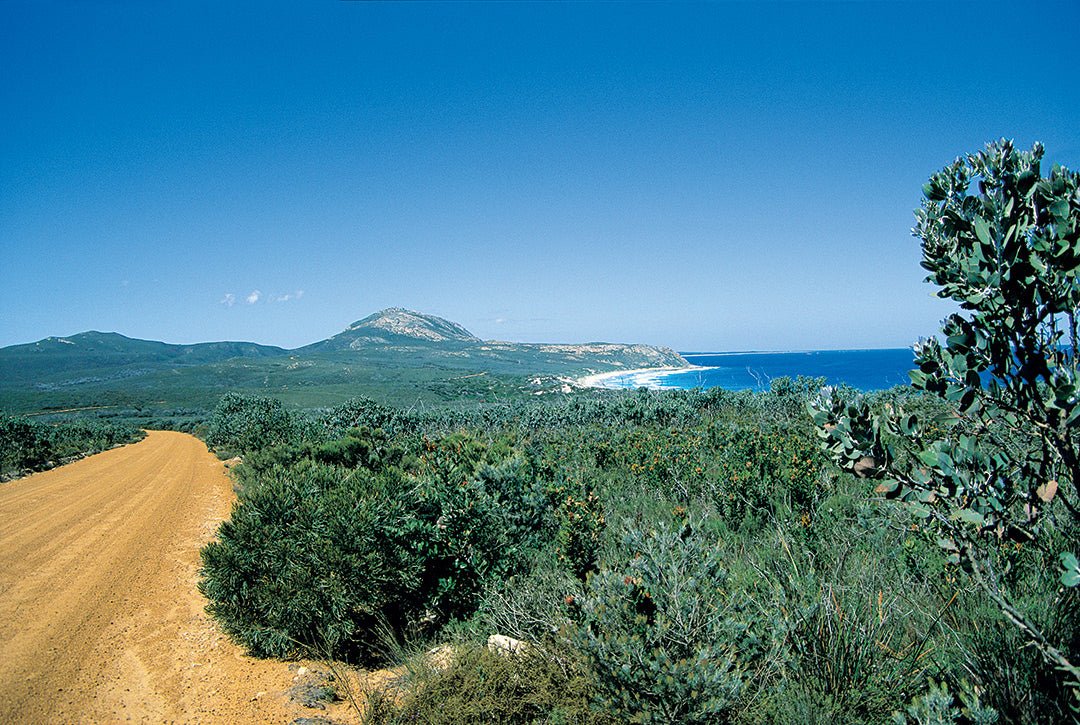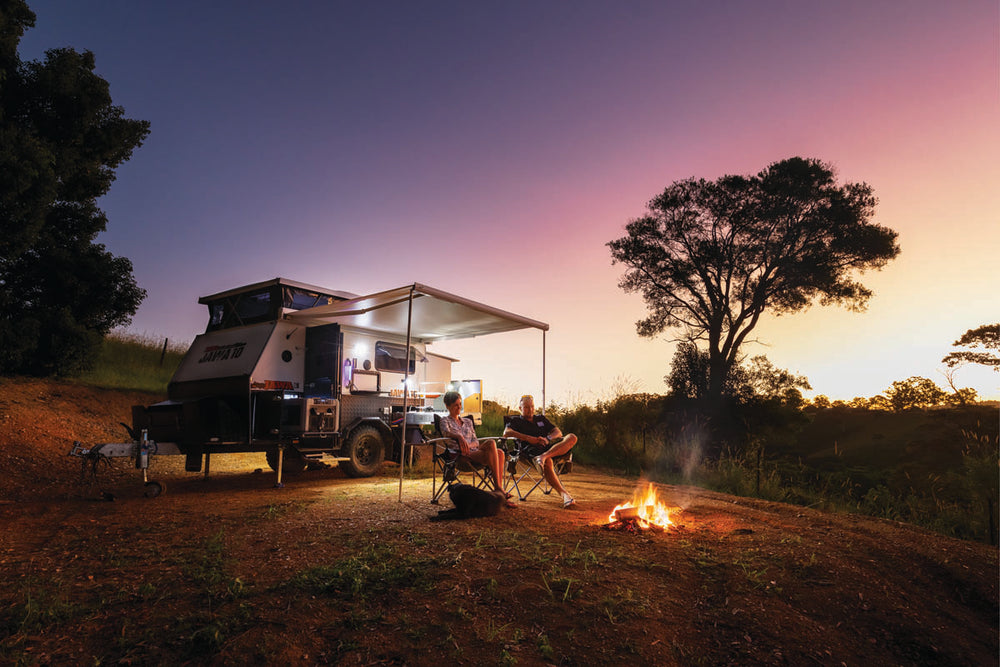

Julia travels along the Fitzgerald Biosphere Coast to discover more of Western Australia’s underrated coastal stretch.
Tell anyone you’re travelling along Western Australia’s coast, and you’ll probably visualise Indian Ocean sunsets and diving into Ningaloo Reef to explore its colourful universe and microscopic wonders. But Ningaloo isn’t the state’s only coastal stretch boastful of a vivid ecosystem.
This time, I’m keeping my head above water and journeying to WA’s south to explore the Fitzgerald Biosphere Coast, 500km southeast of Perth. And like Ningaloo, the Fitzgerald Biosphere Coast is home to vibrant, bountiful and diverse macro-organisms.
The Fitzgerald Biosphere Coast encompasses Fitzgerald River National Park, which extends almost 330,000ha and is one of the largest national parks in the country. The coastal hinterland claims UNESCO status as a Biosphere Reserve, one of the world’s most botanically blessed regions. More than 1800 flora species flourish in its fertile grounds, making up nearly 20 per cent of the state’s plant species, and there are approximately 200 different bird species in the area. The park’s beaches are a mix of pristine and rough. Rugged peaks tower over rare growths adjacent to the Southern Ocean. There’s a lot to take in.
Besides literally smelling the flowers by the sea, my partner and I went on an adventure to the regional towns of Bremer Bay, Hopetoun and Ravensthorpe, all located on Fitzgerald River National Park’s doorstep. And they, too, have plenty of wonders to explore.
 Fitzgerald River National Park
Fitzgerald River National Park
Feeling alive in a sleepy town
We began our southern coastal adventure in Bremer Bay, 505km southeast of Perth. The sleepy town borders Fitzgerald River National Park, 40km from the entry point.
Hardly known as a lively place, the holiday town with a population of around 210 is known for its natural assets: dramatic bluffs, turquoise beaches, secluded coves and rare flora. Lurking in Bremer Bay’s greater waters are its famed residents: orcas (killer whales).
Unlike Ningaloo’s friendlier whales, these apex predator whales are a mission to get to, found 70km off the town’s coast in Bremer Bay Canyon. Filmmaker David Riggs discovered the orca hotspot two decades ago after sensing predatory behaviour in the area. The area boasts one of the biggest seasonal orca whale populations in the Southern Hemisphere, the canyon plunging up to 1km in depth along Australia’s continental shelf. For those brave enough to endure turbulent seas, full-day expeditions to the underwater landmark cost $399 per person and run from December to April.
 Naturaliste Charters, Bremer Bay (Image Tourism WA)
Naturaliste Charters, Bremer Bay (Image Tourism WA)
Unfortunately, we were visiting in late November, so no whale watching for us. Instead, we occupied our time elsewhere: swimming in Little Boat Beach Harbour, a sheltered bay and popular snorkel and dive spot; watching the sun set along coastal granite bluffs; trying local craft beers at nautical-themed Bremer Bay Brewing Co, the most happening place in town; and testing the glutes walking up Tooreburrup Hill Lookout to appreciate 360-degree views of Bremer Bay.
We called Bremer Bay Beaches Resort Tourist and Caravan Park home during our stay, and it was a great place to rest after active days. Although it’s a short drive from the town’s eight beaches, the caravan park is an enclave of green dotted with peppermint trees throughout and surrounded by forest. There are more than 100 shaded caravan sites, including five ensuite sites (up to 22 feet long), unpowered sites (up to 30 feet long) and powered sites (up to 40 feet long) with three ablution blocks in between. While the park receives Telstra reception, it also offers designated areas that accommodate satellites.
A few days in the park
Before we headed off to the towns Ravensthorpe and Hopetoun, we explored what fills the gap in between: Fitzgerald River National Park.
I had previously visited the park in spring, when wildflowers appear like natural confetti. Despite the park not being at its boldest in late November, it was still a wonderland to roam outside peak bloom. The park’s winding roads are flecked with royal hakea — growing up to 3m tall, the sentinel-like shrub’s flowers may be small, but its foliage is a mix of orange, yellow and green. Simply striking.
 Coastal scenery at Quoin Head (Image Tourism WA)
Coastal scenery at Quoin Head (Image Tourism WA)
Our springboard for adventures was Hamersley Inlet Campground, located within the park and managed by the Shire of Ravensthorpe. The tranquil cove straddles between coastal headlands and dramatic ranges and reminded me of mountainous vistas in the UK and Canada, the grey skies adding to the effect. The campground features 14 tiered gravel sites suited for caravans, a basic camp kitchen and two drop toilet facilities just moments from the inlet banks. As Telstra reception is not within range, there is a Starlink with access to free wi-fi.
From here, the campground is moments from hiking trails: a short walk to Hamersley Beach (1.1km); Hamersley Inlet Trail (1.7km); and for those yearning for a longer leg stretch, Hakea Trail (23.5km). As the latter, we tackled a short section of the Hakea Walk Trail around West Beach. Jumbles of grey, shimmering rock formations — many with a splash of oxidisation — stick out from the beach sand like glass shards. It is a unique part of the coastline to wander around battered formations.
 Hamersley Inlet (Image Dene Bingham)
Hamersley Inlet (Image Dene Bingham)
 The camp kitchen at the Hamersley Inlet Campground (Image Dene Bingham)
The camp kitchen at the Hamersley Inlet Campground (Image Dene Bingham)
A trek that is easy on the legs is Point Ann Heritage Trail. The 1.5km coastal trek along the park’s eastern side features remnants of the century-old rabbit-proof fence made famous by the Rabbit-Proof Fence 2002 film highlighting the plight of the Stolen Generation. Along the way, there is a designated platform for watching humpback whales in season. (Hot tip: I recommend downloading the AllTrails app for hiking trail information as reception is limited in the park.)
Heading further east, Cave Point is a remarkable pit stop to grasp the rawness and splendour of the Fitzgerald Coast. A viewing platform is partly suspended over the cliffs; the pounding of waves is unrelenting. But once you can get past the might of the ocean’s roar, the views are expansive and include East Mount Barren. The quartzite peak rises up out of the landscape like an armchair sculptured for giants, overlooking the sea.
 The lookout at Cave Point
The lookout at Cave Point Overlooking Mylies Beach from East Mount Barren (Image Tourism WA)
Overlooking Mylies Beach from East Mount Barren (Image Tourism WA)
Beyond the wildflowers
Even though we were not visiting in bloom season, splashes of colour can be found all year round in Ravensthorpe, 200km northeast of Bremer Bay.
Besides mining, Ravensthorpe is known for being a eucalyptus epicentre, home to 100 species and around 50 hybrids. The town’s other claim to fame is being home to three 25m-high silos that showcase the six growth stages of regional native Banksia baxteri, a particular species that is native to Western Australia. The sky-high murals by Fremantle-based Dutch artist Amok Island are part of the state’s largest outdoor art gallery, the PUBLIC Silo Trail (seven artworks in total).
 Silo art showing the six growth stages of regional native Banksia baxteri
Silo art showing the six growth stages of regional native Banksia baxteri
At a grassroots level, there is the Farm Gate Art Trail. Locals have exercised their creative flair with discarded scrap metals to create 32 farm-inspired sculptures along a 250km route. A few were on our path, including a colossal kettle made of a small silo and decorated with colourful flower stencils. Most impressively, its sprout is an old satellite.
 Artwork on the Farm Gate Trail
Artwork on the Farm Gate Trail There are 32 sculptures along the route
There are 32 sculptures along the route
On the outskirts of town is Ravensthorpe Range, a 40km stretch of low hills. We hit the dirt roads to travel to Archer Drive Lookout, 14km from the town centre. It was an exciting drive and gave us plenty of opportunities to soak up the scenery from easy elevation, and, if you’re inclined, to get closer to more endemic plant species.
Hop to it
Heading 47km south of Ravensthorpe is Hopetoun. The waterfront town features a small shopping strip, including an IGA. Accommodation is also easy on the wallet, with the Hopetoun 48 Hour RV Rest Area located along the Esplanade (you must be self-sufficient and always abide by the rules and restrictions). Potable water is usually available at Hopetoun Groyne and there’s a dump point opposite Wavecrest Village & Tourist Park.
Known as a top fishing spot, Hopetoun is the gateway to the Southern Ocean Road with pristine beaches galore: 2 Mile, 5 Mile, 12 Mile and Mason Bay. 2 Mile Beach is the most convenient, around 3.5km east of the RV rest area. If tempted to return to the wilderness, Fitzgerald River National Park is just a 10-minute drive away. This part of the coast is highly rated.
Fast facts
Accommodation and activities
-
Fitzgerald River Biosphere Coast
P: 08 9838 1191
E: tourism@ravensthrope.com.au -
Fitzgerald River National Park
Park entry fees apply: $17 per vehicle for a standard vehicle, or valid park passes cover the park entry fees. A five-day holiday park pass is $30.
P: 08 9842 4500 -
Bremer Bay Beaches Resort Tourist and Caravan Park
P: 08 9837 4290
E: frontoffice@bremerbaybeaches.com.au -
Naturaliste Charters Whale Watching and Killer Whale Expeditions
P: 08 9750 5500
E: info@whales-australia.com.au -
Fitzgerald Biosphere Coast WA (to book Hamersley Inlet Campground)
P: 08 9838 1191
E: tourism@ravensthorpe.wa.gov.au
Events to add to your calendar
-
Ravensthorpe Wildflower Show and Spring Festival: 8–20 September 2025
See Ravensthorpe in full bloom at the annual Ravensthorpe Wildflower Show. Since 1982, the fair has showcased the region’s floral diversity alongside a myriad of regional activities. -
Hopetoun Annual Fishing Classic: 28 February to 2 March 2026
Local sports group Southerners Sporting Club Hopetoun hosts the annual fishing event every Labour Day long weekend in March.
 Views of Hamersley Road and the Barrens regelia wildflower in the foreground (Image Tourism WA)
Views of Hamersley Road and the Barrens regelia wildflower in the foreground (Image Tourism WA)
THE NEXT STEP
If you want to learn the latest caravan news, find the most innovative new caravans and camping gear or get inspired to plan your next epic road trip to Australia’s beautiful, remote areas, subscribe to our weekly newsletter. We promise to send you only the best content.
If you want to explore some of Western Australia's national parks or iconic destinations, check our these features:
Riding the wave: Wave Rock, Western Australia
The Gibb River Road, WA: Is it caravan friendly?
Best things to see and do on the Turquoise Coast, WA







